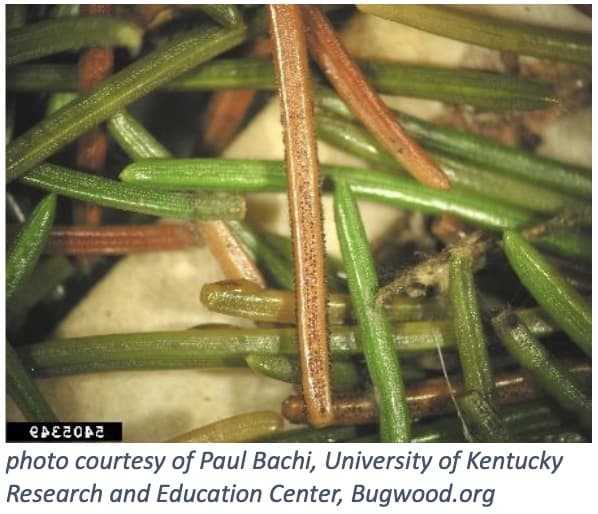Spruce Needlecast
By: Robin Hebert at Frisella Nursery
Mid to late fall is a great time to check on the health of your spruces, especially if you have blue spruces in your landscape. If you are noticing discoloration, dieback and needle drop. there’s a good chance it’s Rhizosphaera Needlecast.


This type of needlecast is caused by the fungus Rhizosphaera kalkhoffii and affects
primarily Colorado spruces and white spruce (Picea pungens and Picea glauca).
These two species are not native to the Midwest and are more likely to struggle in our conditions. Their preferred natural environment is an area with cold winters, cool summers, low humidity and well–drained soil… which is definitely not what we have here in the St. Louis area!
This disease can be further problematic in landscape settings where they are typically planted closer together or in areas with poor airflow. Fungus thrives in moist environments with minimal air disturbance so the layout and design of a landscape can often make the problem worse.
Proper watering is crucial when dealing with Rhizosphaera, or any fungus for that matter. Avoid overhead watering your spruces whenever possible. This allows moisture to penetrate the dense foliage and creates an environment perfectly
suited for fungus populations. Also, the root systems of spruces do not tolerate “wet feet”. While they do need a lot of water, the structure of their root systems needs excess water to drain away quickly. Heavy clay soils and low-lying areas are usually the worst spots to plant a spruce.
The actual infection takes place in spring primarily on new growth, but symptoms don’t typically show up until the following spring and summer. The fungus can sometimes be seen with a hand lens as tiny black spots called pycnidia. This is the fruiting body of the fungus as it emerges from the pores on the needles. The most obvious symptom of Rhizosphaera is the pattern of needle browning. Starting at the bottom and working up the tree, needles will become yellow and spotted (purplish brown on Colorado spruces). Then they’ll turn completely brown and start falling off the tree in late summer/ fall.


Life Cycle:
• The fungus overwinters in infected needles and debris on the ground.
• Spores are released from the infected needles during spring wet weather when the temperature reaches around 77° F, usually in April or May.
• The spores are spread primarily by rain water splashing up into the base of the tree. This is why the browning typically occurs from the bottom up.
• Needles may appear healthy for most of the spring and summer, even though they may be infected. These needles usually turn a mottled yellow by late summer.
• They then turn brown (purplish on Colorado spruces) and fall off during the summer and fall.
Treatment:
• Plant spruces that are considered resistant (e.g. Norway spruce)
• Get a positive identification of the disease because there are other non-infectious diseases that may mimic needlecast symptoms.
• Provide good air circulation by spacing plants properly and selectively pruning to open up the interior of the tree.
• Prune lower branches to at least 6” above the ground, making sure that there are no branches touching the soil surface.
• Avoid overhead watering and watering at night.
• Remove all infected needles from the ground and destroy – DO NOT COMPOST!
• Chemical controls are applied preventatively in the spring and are only effective if the disease is not too severe. Fungicides should be applied to affected trees beginning in May when the new growth (candles) are developing. Follow up with two more sprays timed 10-14 days apart
• Because this fungus takes 12-18 months for symptoms to appear, at least two years of fungicide sprays are usually required. Continued treatments may be needed to reduce reinfection.